It's a commonly reported fact that it costs six-seven times the amount of money to gain a new customer than to keep an existing one.. So it comes as no surprise that customer acquisition costs can be a serious drain for a SaaS startup. The focus on fast growth in the early stages of building your business means that customer retention strategies often fall by the wayside in favor of chasing new clients. Navigating this challenge involves recognizing and enhancing customer lifetime value – the potential value a customer brings to your business over time. Striking a balance between acquisition and retention efforts is crucial, and implementing effective customer retention strategies is key to achieving long-term success. Upholding high levels of customer satisfaction further solidifies the foundation for sustained growth in this dynamic landscape.
Check out the following articles to learn more about saas marketing:
- The Best Beginner's Guide to SaaS Lead Generation Today
- How to Innovate SaaS Marketing for 2023 and Beyond
- How to Convert SaaS Trial Users with Inbound Marketing
It’s like expert SaaS consultant Nichole Elizabeth DeMeré says:
“When all of your customer acquisition effort and budget is spent just trying to replace existing customers who’ve left, growth is sluggish — if it happens at all.”
Think of it like this:
Imagine you’re trying to create a beautiful garden. Every spring, you plant new bulbs which bloom through the summer. In your excitement to add more plants, you forget to water the flowers that you worked so hard to grow in the first place. They dry up, wither, and disappear.
These are the customers you’ve failed to delight.
Anyone even remotely familiar with the inbound methodology will know that “delight” is the last of the four crucial processes of turning strangers into wildly enthusiastic promoters of your product.
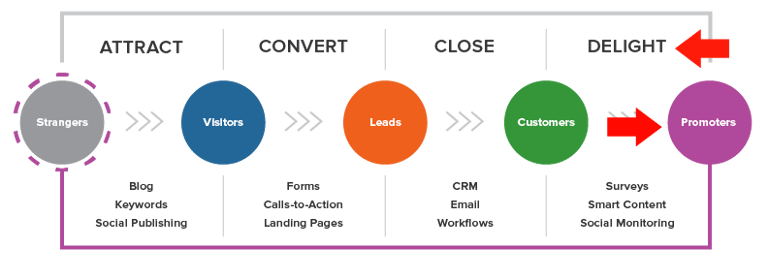
For a more intelligent integrated inbound methodology which we developed specifically for SaaS and tech businesses, see the diagram below.

These promoters are essential for building a reputable, trusted brand that people will return to, time and time again.
A 2014 study by Ogilvy, Google and TNS found that 74% of people are influenced by word-of-mouth, more than any other marketing method. This includes not just people talking to friends and family, but those all-important online reviews and comments.
If your customers feel like they're receiving a great service, with useful functions and plenty of support from your team (before and, even more importantly, after purchase), they'll develop positive feelings and willingly share their experiences with potential new customers. Navigating the intricacies of the customer journey is crucial for ensuring a seamless and positive experience from initial engagement through post-purchase interactions. By strategically enhancing the overall customer lifetime, you not only foster positive sentiments but also contribute to a higher customer retention rate. This, in turn, establishes a robust foundation for positive word-of-mouth and sustainable business growth, creating a cycle where satisfied customers become brand advocates, actively shaping the success of your business.
Of course, with a negative opinion… Well we all know what happens then.
For SaaS startups, customer retention is especially important.
You’re part of a growing industry with a ton of competition. It’s also notorious for customer churn, which is a slow leak of your customer base that will absolutely sink your business if it’s not carefully monitored and attended to.
[inline-form]The Ultimate Checklist: Reduce Your SaaS Churn[inline-form]
Okay, I hear you.
Enough of why it's so important for my business, how do I start delighting and retaining SaaS customers?
1. Pay attention to your customer and build a genuine relationship
When you were developing your marketing strategy, you identified your ideal buyer personas. You’ve learned all you can about your customer during the acquisition and buying process and now have access to a wealth of data about their habits and needs.
Use this to provide them with personalised, helpful content and advice.
For instance, imagine you've developed a brilliant app tailored to assist university students in their revision journey. Once they've downloaded your app, consider providing additional value. How about crafting insightful blog articles on maintaining a balance between studying and an active social life, or offering tips for managing exam stress? You can then share these insights with your customers through an engaging email newsletter. This approach isn't just about acquiring new users; it reflects a strategic move commonly employed by many SaaS companies. By consistently offering valuable resources, you not only enhance the overall user experience but also focus on retaining customers and building customer loyalty. This comprehensive strategy contributes to a more engaged user base, strengthening the long-term sustainability of your product in the competitive market.
To truly delight your SaaS customers, you need to stop thinking of the purchase of your product as the one and only goal of your business.
The goal is not just to create customers, but to create active, happy promoters.
2. Use social media
The effect of social media on consumer buying habits cannot be underestimated. It’s where customers will go to find out more about your product and the values and culture of your business.
Because of this, it’s absolutely essential that you find the right social media channels and the correct ‘voice’ for interacting with your current and future customers.
If, for example, you’re selling document sharing software for offices, you’re likely to get much more attention with thoughtful, well-researched posts on a channel aimed at professionals like LinkedIn, than you are with emoji-filled captions and cute photos on Instagram.
Take the time to really examine who uses which channel and how they use it.
It could be that your business would benefit more from interacting with a niche community with specialised knowledge. If you feel like this is the case, spend time building a good reputation in dedicated forums on a platform like Reddit.
Check out the infographic below for an overview of how the largest social networks are being used.
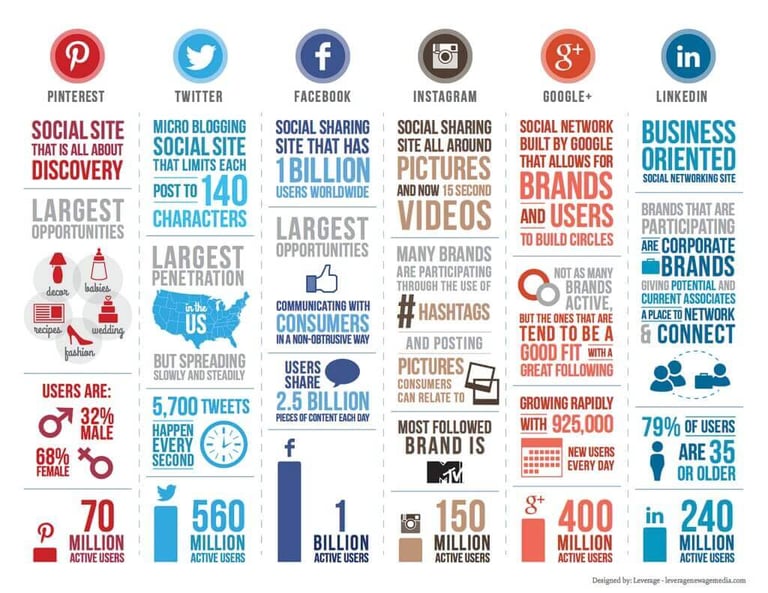
Once you've established your presence on social media, directing your focus towards generating content that genuinely delights your fan base, followers, and professional connections is key. The inherently shareable nature of social media content positions it as a powerful tool for effective word-of-mouth marketing.
To ensure the ongoing success of your venture, it's essential to keep a close eye on crucial financial indicators such as monthly recurring revenue. This metric provides a clear snapshot of your regular income flow, enabling strategic decisions for sustainable growth. Complementing this, the implementation of SaaS customer retention strategies is paramount in the current competitive landscape. Prioritising customer satisfaction and loyalty ensures a consistent and reliable revenue stream.
Moreover, actively seeking and incorporating customer feedback becomes integral to refining your offerings and services. Understanding your customers' experiences, preferences, and concerns provides valuable insights that can drive continuous improvement. By seamlessly integrating these elements, you create a comprehensive strategy that not only sustains but propels your business towards enduring success.
(Remember how important that is?)
A great social media strategy will keep you front and centre in your customer’s minds, and prove that you’re active and available to provide support.
And on the subject of providing support…
3. Have amazing customer service
There’s nothing more frustrating than running into an issue and having to wait days or even weeks to get it fixed. The sad fact is, many people will just turn to a competitor, regardless of how much they liked your business to begin with.
It doesn’t matter that your product is the most incredible, ground-breaking, function-packed piece of software to ever hit the market (it definitely is), if your customer can’t use it, and can’t get access to anyone that will help them, it’s never going to be successful.
Even the most user-friendly product in the world is still going to leave a few people totally stumped. You can provide all the FAQ’s and guides you like, but it’s never going to beat having a real human walk your customer through the problem.
Social media is littered with stories of companies going above and beyond with their customer service and providing a truly delightful experience. Some of these stories even go viral, which is word-of-mouth marketing in overdrive.
Check out the feed for Spotify’s dedicated tech support Twitter, @SpotifyCares. They make use of ‘Featured’ tweets to draw attention to the customers that they’ve recently helped.
The highlighted examples are glowing reviews that actually offer important feedback about what customers really like about Spotify’s customer service. In this case, customers are especially appreciative of the speed and how empathetic their reps are.
These are excellent lessons to incorporate into your own customer support strategy.
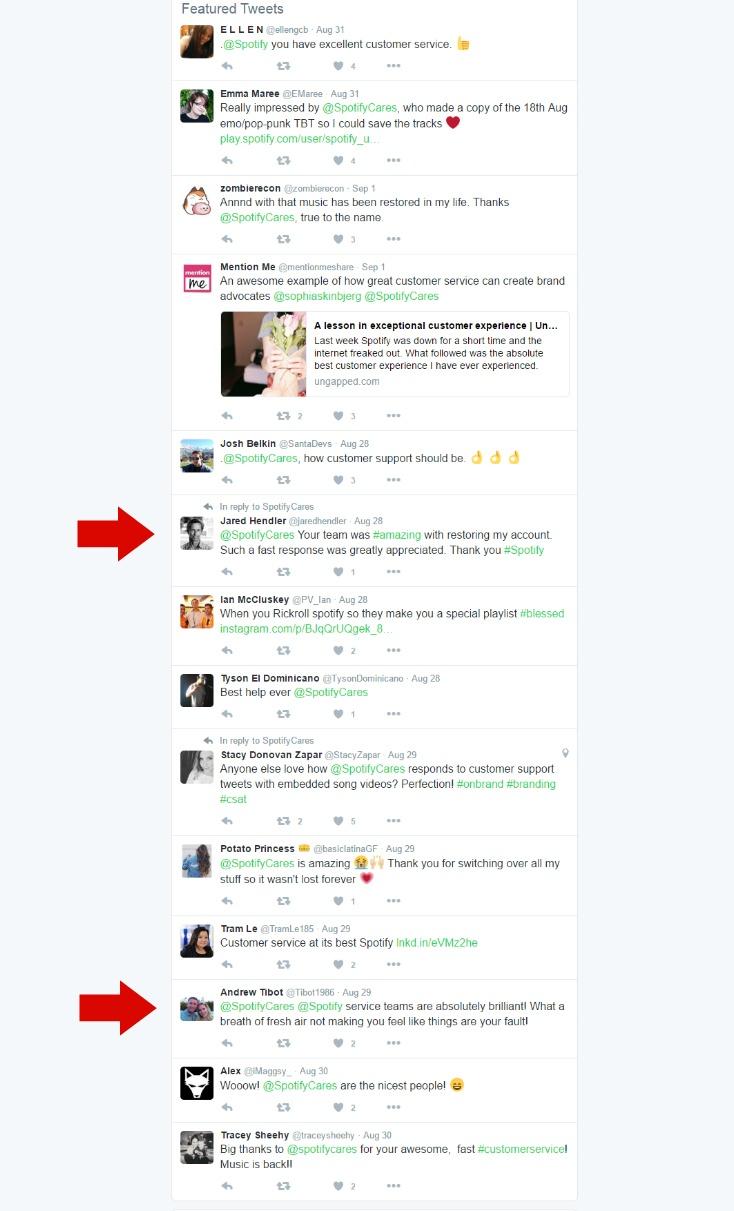
They combine social media, a fun, personable ‘voice’ and tech support for killer word-of-mouth marketing.
You can’t buy that kind of positive exposure, it has to be earned.
Terrible customer service will also get massive exposure, and let me assure you, “there’s no such thing as bad publicity” definitely does not apply here.
So, you’re connecting with your customers with personalised content, you’ve got active, engaging social media feeds, and you’re providing awesome customer service on a daily basis. What more could you possibly do?
4. Put feedback into action
Fostering a positive relationship with your SaaS customers is the number one most important thing in delighting and retaining them.
And in any great relationship, the key is communication.
Now, when I say communication, I don’t mean just sending out all your great content, witty tweets and helpful advice, but in listening.
You have to listen to your customers!
They will tell you exactly what you need to do to be a more successful business.
I don’t mean to say that they will send you carefully written emails with tons of insightful, actionable advice (if only), but their behaviour will let you know exactly what you’re doing right (and more importantly, what you’re doing wrong.)
A brilliant method of collecting real-time data on problems you can address is with the use of a live chat on your website. It also doubles as another opportunity to provide great customer service, so make sure it’s manned by someone who knows your product inside out.
Check out the example below from the travel agency Thomas Cook.
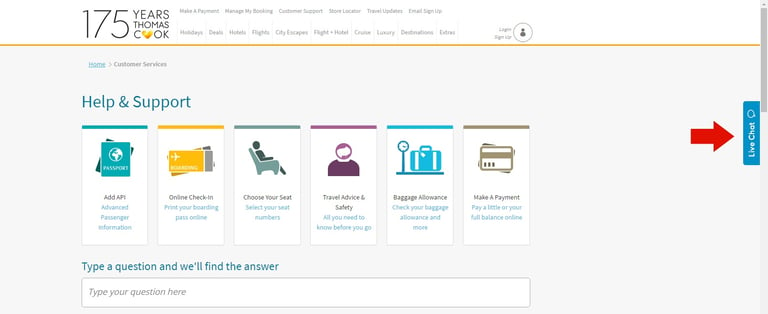
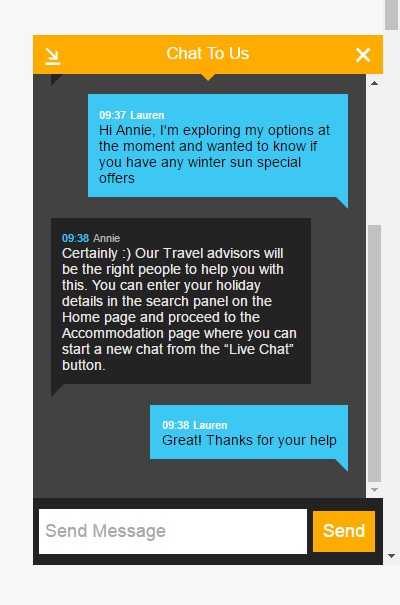
Here, a rep called Annie was able to redirect a potential customer to another employee who was better equipped to respond to their query. This reduced friction in the customer’s journey through the website and means that they’re now more likely to have a positive experience.
By identifying herself by name, and using an emoticon, Annie was able to humanise the company and give the customer a real person to communicate with.
Combining live chat with a personable, talented salesman on the other end will let you upsell your products and move people through your sales funnel. And that’s on top of all that invaluable instant feedback you’re getting!
It’d be great if customers would always tell you exactly what problems they’re experiencing, but unfortunately, it just isn’t that simple.
So how else can you figure out what needs to change?
You need to make sure you monitor all of the ways that customers interact with your business and your product.
For example, are people unsubscribing to your email newsletters? Make sure you gather data on the reasons why and start adjusting the content within them and the frequency with which you send them. Isolate each variable and see how it affects the number and length of subscriptions.
It will take time, but eventually you will land on the recipe for success, and hey presto, you’ve got a delighted customer who finds value in your communication.
You should also pay careful attention to what customers are saying when they contact you for tech support. If it’s a certain function that a large portion of them seem to be having problems with, see what you can do to make it more user friendly.
There is always opportunity to change, grow and adapt.
You must be reactive if you want to stay in the game and continue to give your customers a delightful experience long after purchase.
With these tips, you’ll soon be on your way to an effective strategy for delighting and retaining your SaaS customers.









